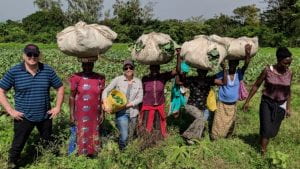
Phillip Griffiths, associate professor in the Horticulture Section of the School of Integrative Plant Science based at Cornell AgriTech, has a special connection in East Africa that’s improving the humble collard green to help smallholder farmers—and their communities—live and eat better. Griffiths’ East African connection was made when Charles Wasonga, recipient of the first Cornell Assistantship for Horticulture in Africa (CAHA), began his Ph.D. studies with Griffiths. The design of CAHA, which requires advisors to work alongside students on research in their home country, brought Griffiths to Kenya to oversee Wasonga’s work on green beans. While there, the two also saw a number of collard fields and realized the significant challenges farmers had in getting fresh, desirable products to rapidly urbanizing markets.
“The issue with fresh-market crops versus agronomic crops, like maize, is always getting them to end users. Farmers need to focus on marketable yield,” said Griffiths, associate professor of horticulture, plant breeding and genetics.
In Kenyan diets, collard greens—a member of the Brassica family—are a nutritious dietary staple for millions of people. Like all dark leafy greens, they’re high in vitamin A and a good source of calcium, iron and vitamin C. But collards are highly susceptible to black rot, which can reduce marketability by 50% to 80%. This susceptibility makes the crop a risky venture for small farmers looking to expand their income options with vegetables.
Recognizing the vulnerabilities that would have to be overcome, Wasonga and Griffiths started crossing several kale and collard varieties at Cornell with the goal of breeding for improved resistance to black rot. After Wasonga returned to Kenya, Griffiths applied for and was chosen as a David R. Atkinson Center for a Sustainable Future Academic Venture Fund project to continue the collaboration and investigate more diverse leafy Brassica vegetables in Kenya and Tanzania.


